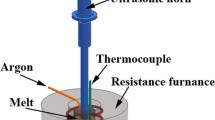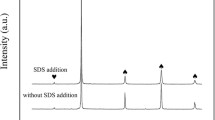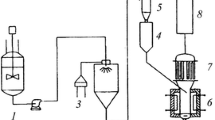Abstract
In order to improve the homogeneous distribution of the TiC particles and facilitate the TiC particles to distribute in the tungsten grain interiors, two kinds of TiC-doped tungsten precursors with a core–shell structure were prepared by an improved wet chemical method at different reaction temperature conditions. Consequently, fine plate-like precursor (200–400 nm) and flower-like precursor (approximately 1.25 μm) are obtained. After reduction and sintering, the microstructures of the samples were characterized by scanning electron microscopy and transmission electron microscopy. In the sample sintered from the plate-like precursor, TiC particles with sizes in the range of 40–300 nm and an average size of approximately 80 nm were uniformly distributed in the tungsten matrix with a high share in the grain interiors. However, in the sample sintered from the flower-like precursor, the TiC particles with sizes in the range of 50–700 nm are significantly aggregated and non-uniformly distributed in the tungsten matrix. As a result, the sample sintered from the plate-like precursor achieves higher mechanical properties and a much narrower range of bending strength values than that sintered from the flower-like precursor. The average bending strength of the sample sintered from the plate-like precursor is 655 MPa, which is higher than that of the sample sintered from the flower-like precursor (524 MPa). Different reaction mechanisms and dispersing stabilities of the TiC particles at different temperature conditions should be accounted for the differences between the two samples.








Similar content being viewed by others
References
Smid I, Akiba M, Vieider G, Plöchl L. Development of tungsten armor and bonding to copper for plasma interactive components. J Nucl Mater. 1998;258–263(1):160.
Philipps V. Tungsten as material for plasma-facing components in fusion devices. J Nucl Mater. 2011;415(1):S2.
Kim Y, Lee KH, Kim EP, Cheong DI, Hong SH. Fabrication of high temperature oxides dispersion strengthened tungsten composites by spark plasma sintering process. Int J Refract Met Hard Mater. 2009;27(5):842.
Kitsunai Y, Kurishita H, Kuwabara T, Narui M, Hasegawa M, Takida T, Takebe K. Radiation embrittlement behavior of finegrained molybdenum alloy with 0.2 wt% TiC addition. J Nucl Mater. 2005;346(2–3):233.
Kurishita H, Arakawa H, Matsuo S, Sakamoto T, Kobayashi S, Nakai K, Pintsuk G, Linke J, Tsurekawa S, Yardley V, Tokunaga K, Takida T, Katoh M, Ikegaya A, Ueda Y, Kawai M, Yoshida N. Development of nanostructured tungsten based materials resistant to recrystallization and/or radiation induced embrittlement. Mater Trans. 2013;54(4):456.
Kurishita H, Matsuo S, Arakawa H, Sakamoto T, Kobayashi S, Nakai K, Okano H, Watanabe H, Yoshida N, Torikai Y, Hatano Y, Takida T, Kato M, Ikegaya A, Ueda Y, Hatakeyama M, Shikama T. Current status of nanostructured tungsten-based materials development. Phys Scr. 2014;2014(T159):014032.
**e ZM, Liu R, Miao S, Yang XD, Zhang T, Wang XP, Fang QF, Liu CS, Luo GN, Lian YY, Liu X. Extraordinary high ductility/strength of the interface designed bulk W-ZrC alloy plate at relatively low temperature. Sci Rep. 2015;5:16014.
**e ZM, Liu R, Zhang T, Fang QF, Liu CS, Liu X, Luo GN. Achieving high strength/ductility in bulk W-Zr-Y2O3 alloy plate with hybrid microstructure. Mater Des. 2016;107:144.
Liu G, Zhang GJ, Jiang F, Ding XD, Sun YJ, Sun J, Ma E. Nanostructured high-strength molybdenum alloys with unprecedented tensile ductility. Nat Mater. 2013;12(4):344.
Wahlberg S, Yar MA, Abuelnaga MO, Salem HG, Johnsson M, Muhammed M. Fabrication of nanostructured W-Y2O3 materials by chemical methods. J Mater Chem. 2012;22(25):12622.
Dong Z, Liu N, Ma Z, Liu C, Guo Q, Liu Y. Preparation of ultra-fine grain W-Y2O3 alloy by an improved wet chemical method and two-step spark plasma sintering. J Alloy Compd. 2017;695:2969.
Lang S, Yan Q, Sun N, Zhang X, Deng L, Wang Y, Ge C. Microstructure, basic thermal-mechanical and Charpy impact properties of W-0.1wt.%TiC alloy via chemical method. J Alloy Compd. 2016;660:184.
Yar MA, Wahlberg S, Bergqvist H, Salem HG, Johnsson M, Muhammed M. Chemically produced nanostructured ODS-lanthanum oxide-tungsten composites sintered by spark plasma. J Nucl Mater. 2011;408(2):129.
**a M, Yan Q, Xu L, Guo H, Zhu L, Ge C. Bulk tungsten with uniformly dispersed La2O3 nanoparticles sintered from co-precipitated La2O3/W nanoparticles. J Nucl Mater. 2013;434(1–3):85.
Zhang XX, Yan QZ, Yang CT, Wang TN, **a M, Ge CC. Recrystallization temperature of tungsten with different deformation degrees. Rare Met. 2016;35(7):566.
Veleva L, Oksiuta Z, Vogt U, Baluc N. Sintering and characterization of W-Y and W-Y2O3 materials. Fusion Eng Des. 2009;84(7–11):1920.
Zhao M, Zhou Z, Zhong M, Tan J, Lian Y, Liu X. Thermal shock behavior of fine grained W-Y2O3 materials fabricated via two different manufacturing technologies. J Nucl Mater. 2016;470:236.
Liu R, **e ZM, Fang QF, Zhang T, Wang XP, Hao T, Liu CS, Dai Y. Nanostructured yttria dispersion-strengthened tungsten synthesized by sol-gel method. J Alloy Compd. 2016;657:73.
Kurishita H, Matsuo S, Arakawa H, Sakamoto T, Kobayashi S, Nakai K, Takida T, Kato M, Kawai M, Yoshida N. Development of re-crystallized W-1.1%TiC with enhanced room-temperature ductility and radiation performance. J Nucl Mater. 2010;398(1–3):87.
Song GM, Wang YJ, Zhou Y. Thermal-mechanical properties of TiC particle-reinforced tungsten composites for high temperature applications. Int J Refract Met Hard Mater. 2003;21(1–2):1.
**a M, Yan Q, Xu L, Zhu L, Guo H, Ge C. Synthesis of TiC/W core-shell nanoparticles by precipitate-coating process. J Nucl Mater. 2012;430(1–3):216.
Kurishita H, Matsuo S, Arakawa H, Narui M, Yamazaki M, Sakamoto T, Kobayashi S, Nakai K, Takida T, Takebe K, Kawai M, Yoshida N. High temperature tensile properties and their application to toughness enhancement in ultra-fine grained W-(0-1.5) wt% TiC. J Nucl Mater. 2009;386–388:579.
Lang S, Yan Q, Wang Y, Zhang X, Sun N, Deng L, Ge C. Preparation and microstructure characterization of W-0.1wt.%TiC alloy via chemical method. Int J Refract Met Hard Mater. 2016;55:33.
Lassner E, Schubert WD. Tungsten: Properties, Chemistry, Technology of the Element, Alloys, and Chemical Compounds. New York: Kluwer Academic/Plenum Publishers; 1999. 119.
Livage J, Guzman G. Aqueous precursors for electrochromic tungsten oxide hydrates. Solid State Ionics. 1996;84(3):205.
Yang J, Li W, Li J, Sun D, Chen Q. Hydrothermal synthesis and photoelectrochemical properties of vertically aligned tungsten trioxide (hydrate) plate-like arrays fabricated directly on FTO substrates. J Mater Chem. 2012;22(34):17744.
Huang J, Xu X, Gu C, Yang M, Yang M, Liu J. Large-scale synthesis of hydrated tungsten oxide 3D architectures by a simple chemical solution route and their gas-sensing properties. J Mater Chem. 2011;21(35):13283.
Miao B, Zeng W, Lin L, Xu S, Ding X. Syntheses and mechanism of WO3·H2O nanoflowers assembled of square nanoplates with the assistance of oxalic acid. Nanosci Nanotech Lett. 2013;5(7):765.
Li D, Kaner RB. How nucleation affects the aggregation of nanoparticles. J Mater Chem. 2007;17(22):2279.
Hattori K, Moriyama N, Shinoda K. The effect of temperature on the stability of polyethylene suspensions in water dispersed with nonionic surfactants. Nippon Kagaku Zassi. 1967;88(10):1030.
Moriyama N, Tokiwa F. Stabilities of disperse dye suspensions dispersed with various types of surfactants at high temperature. J Jpn Oil Chem Soc. 1971;20(1):41.
Acknowledgements
This study was financially supported by the ITER-National Magnetic Confinement Fusion Program (No. 2014GB123000).
Author information
Authors and Affiliations
Corresponding author
Rights and permissions
About this article
Cite this article
Lang, ST., Yan, QZ., Sun, NB. et al. Preparation of W–TiC alloys from core–shell structure powders synthesized by an improved wet chemical method. Rare Met. 42, 1378–1386 (2023). https://doi.org/10.1007/s12598-018-1066-2
Received:
Revised:
Accepted:
Published:
Issue Date:
DOI: https://doi.org/10.1007/s12598-018-1066-2




